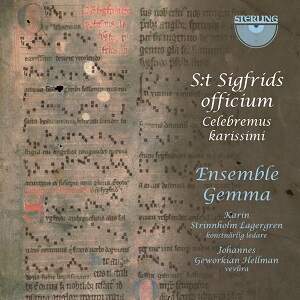
S:t Sigfrids Officium – Celebrimus karissimi
Ensemble Gemma/Karin Strinnholm Lagergren
Johannes Geworkian Hellman (hurdy-gurdy)
rec. 2019, Hemmesjö New Church, Sweden
Texts and translations included
STERLING CDA1840-2 [57]
Saints – people who were considered worthy of veneration for their holiness or sanctity – have played a major role in the Christian church from early times. Part of the ecclesiastical year were days on which the life of a saint was celebrated. The fixed parts of the liturgy were extended by chants – antiphons and responsories – specifically connected to him or her, and especially the miracles which took place during his or her life. “This combination of recitation from the saint’s legend and chants about the saint is called an Office or historia. The celebration started already the night before at vespers, and ended with vespers on the next day, that is, on the saint’s day …” (booklet).
The Office or Historia which is performed here – or rather excerpts of it – is about St Sigfrid, known as Sigfrid of Sweden, who was a missionary-bishop during the first half of the 11th century. He is credited with the baptism of the first monarch of Sweden, Olof Skötkonung. A feature of the celebrations of saints is that many stories from their lives are undoubtedly legends. It is often hard to discern between historical facts and stories that are the product of fantasy by those who venerate him or her. In the booklet to the recording under review here, Per Stille, associate professor of Scandinavian languages at Linnaeus University in Växjö (the place where Sigfrid died), argues that the legend of Sigfrid’s life has been underappreciated as a historical source, and includes some historical facts about Sigfrid. Whereas it has been stated, for instance, that the Christianization of Sweden took place much later, newer research has revealed that Christianity was established in the early 11th century, and Sigfrid may have been active at the time.
The 15th of February is Saint Sigfrid’s Day, and at that occasion the Office of St Sigfrid was performed. In the various chants the story of his life is told, but as we only get parts of the Office, it is not a complete account. One important element is a miracle. “The legend also relates how the people murder his nephews and associates, and lower their heads in a tub into a lake near the church (…). Through divine intervention the heads float up with a light shining over them; thus Sigfrid can find the heads of his murdered nephews.”
As no complete Office has been preserved from a particular time, the chants included here date from different eras, from the 13th to 16th centuries. Whereas the antiphons and responsories of the matins focus on the story of a saint’s life, the antiphons of lauds are about miracles that have taken place after the death of the saint, and are connected to him or her. The recording does not follow a strict liturgical order. Not all the chants are on original music; in some cases we have to do with adaptions from other chants.
In their way of singing the ensemble attempts to reconstruct the performance practice of the Middle Ages; the Latin pronunciation is based on what was common at the time in Sweden. However, the contributions of the hurdy-gurdy indicate that no attempt has been made to reconstruct an actual performance in ancient times. Apart from improvisations on some of the chants, in several items the singers are accompanied by the hurdy-gurdy, which is certainly not in line with how the chants were performed in the Middle Ages. It is rather meant “as a contribution to the whole through variation and dynamics.” I find that decision regrettable. The improvisations take also quite some time. I would have preferred a larger selection of chants.
For those who are interested in liturgical music, and in particular ancient liturgical practices, this is a very interesting disc to have. Scandinavia is probably a part of Europe about whose religious and liturgical history they may know very little. The notes in the booklet are very useful to get to know more about it. The figure of St Sigfrid may also be largely unknown outside Scandinavia. From that perspective this disc fills some gaps in our knowledge of European religious and musical history. The singing of the ladies who are members of the Ensemble Gemma is excellent. It is very nice how they are able to realize the differences between the chants. Some are a clear expression of the excitement which can be part of the veneration of a saint, and that comes off very well here.
Johan van Veen
www.musica-dei-donum.org
twitter.com/johanvanveen
Help us financially by purchasing from


Contents
plainchant
Celebrimus karissimi (instr)*
Antiphon: Celebrimus karissimi – Psalm 109: Dixit Dominus
Antiphon: Is namque
Antiphon: Auditio namque
Auditio namque (instr)*
Antiphon: Evolutio quoque – Psalm 4: Cum invocarem
Antiphon: Ibi nempe
Ibi nempe (instr)*
Antiphon: Rex igitur Suecie
Antiphon: Predicante itaque
Antiphon: Dolens igitur diabolus*
Antiphon: Tres siquidem cum eo
Antiphon: Concitat continuo
Responsory: Dilectus dei athleta
Concitat continuo (instr)*
Responsory: Sacerdos dei Sigfridus
Responsory: Accelerat denique
Responsory: Sanctus Sigfridus cum dedens*
Christi fidelis famulus (instr)*
Benedictus antiphon: Christi fidelis famulus – Benedictus
Hymn: Laudes atques preconia*
* hurdy-gurdy


















